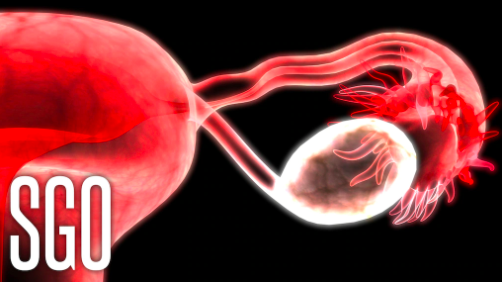Responses in 37% of patients with AVB-500, higher without prior bevacizumab.
By Charles Bankhead
More than a third of patients with platinum-resistant ovarian cancer had objective responses to chemotherapy plus a small-molecule inhibitor that targets resistance-associated signaling, a preliminary study showed.
Seven of 19 patients responded to the combination of paclitaxel and the GAS6/AXL inhibitor AVB-500, as did four of 26 patients who received AVB-500 plus pegylated liposomal doxorubicin (PLD). Subgroup analyses showed greater activity with paclitaxel/AVB-500 in patients with a platinum-free interval (PFI) of less than 3 months and in those who had not received bevacizumab (Avastin).
A majority of patients had grade 3/4 adverse events (AEs), primarily associated with chemotherapy, reported Katherine Fuh, MD, PhD, of Washington University in St. Louis, at the Society of Gynecologic Oncology virtual meeting.
“There is substantial evidence for benefit of AVB-500 and paclitaxel,” said Fuh. “The objective response rate was 37% for the entire cohort, 50% for the high MEC, or minimal efficacious concentration-high group, and 67% for the no-prior bevacizumab exposure group versus 10% in the prior bevacizumab group.”
“Proprietary serum soluble AXL/GAS6 may be able to identify who will best respond. This will continue to be evaluated in GOG 3059/ENGOT OV66, an upcoming phase III clinical trial comparing weekly paclitaxel to weekly paclitaxel/AVB-500,” she stated.
Binding of the ligand GAS6 to AXL can lead to therapy resistance and induce the epithelial-to-mesenchymal transition, which is involved in tumor progression, metastatic expansion, and generation of tumors cells that have stem cell-like properties. Fuh and colleagues have shown that increased AXL expression correlates with chemoresistance and poor prognosis, and inactivation of AXL increases tumor cell susceptibility to paclitaxel and increased intratumoral concentrations of the chemotherapeutic drug.
AVB-500 is an AXL decoy protein that selectively inhibits GAS6/AXL signaling. By means of protein engineering, the decoy receptor has a high affinity for GAS6, an activator of AXL in preclinical cancer models. The safety of AVB-500 was demonstrated in a study of healthy volunteers, leading to the phase Ib trial reported by Fuh.
Eligible patients had platinum-resistant, high-grade serous ovarian cancer, endometrioid or undifferentiated adenocarcinoma histology, and one to three prior lines of therapy. The trial comprised two patient cohorts: paclitaxel plus escalating doses of AVB-500 or PLD plus AVB-500. The primary outcomes were safety and antitumor activity.
Data analysis included 53 patients (23 in the paclitaxel arm, 30 in the PLD group) who had a mean age of 64. Almost 90% of the patients had high-grade serous disease. Almost half of the patients had received bevacizumab, and a fourth had received a PARP inhibitor prior to enrollment. About 80% of the patients had received one or two prior lines of therapy. A third of the study population had a PFI of <3 months and the rest had PFIs of 3-6 months.
The safety analysis included all 53 patients enrolled in the trial. Treatment-related adverse events (TRAEs) occurred in 18 (78.3%) patients in the paclitaxel group and 19 (63.3%) of the PLD group. Grade ≥3 TRAEs in the paclitaxel and PLD groups included fatigue (26.1% vs 16.7%), infusion-related reaction (21.7% vs 20.0%), anemia (21.7% vs 6.7%), and nausea (13% vs 13.3%).
The efficacy analysis included 44 patients from the two arms combined. In the paclitaxel arm, seven of 19 (36.8%) patients had objective responses, including two complete responses. An additional six patients had stable disease, resulting in a clinical benefit rate (CBR) of 68.4%.
In the PLD arm, four of 25 (16%) patients responded, all partial responses. Eleven patients had stable disease, resulting in a CBR of 60%.
Median progression-free survival was 3.6 months in both treatment groups. Media overall survival (OS) was 14.1 months in the paclitaxel group and 12.6 months in the PLD group.
An analysis of survival by MEC in the paclitaxel arm (trough level of 13.8 mg/L) showed that 10 patients with trough levels exceeding the MEC had a median PFS of 7.5 months, objective response rate of 50%, and median OS of 19.0 months. Among nine patients with MEC below 13.8 mg/L had median PFS of 2.8 months, response rate of 22.2%, and median OS of 8.7 months.
Analysis of the paclitaxel group by prior bevacizumab exposure showed that six of nine patients with no prior exposure responded to the treatment, and one had stable disease. Among 10 patients previously treated with bevacizumab, one patient had an objective response and five had stable disease.
A preliminary biomarker analysis showed that patients with a higher baseline AXL/GAS6 ratio were significantly (P=0.047) more likely to respond to AVB-500, said Fuh. Specifically, all responding patients had a baseline ratio exceeding 0.773.
The finding that prior bevacizumab exposure might influence response to AVB-500 is intriguing, according to invited discussant Ursula A. Matulonis, MD, of Dana-Farber Cancer Institute in Boston. That observation should be evaluated further in the phase III trial, including an investigation into potential mechanisms underlying the interaction.
This article was published by MedPage Today.


